British 20th-century painting
The big rupture
How the Great War transformed a group of artists
-
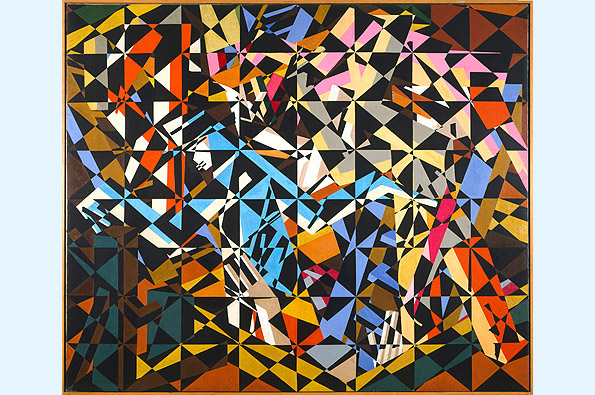 “In the Hold” by David Bomberg, 1913-14Tate, London
“In the Hold” by David Bomberg, 1913-14Tate, London -
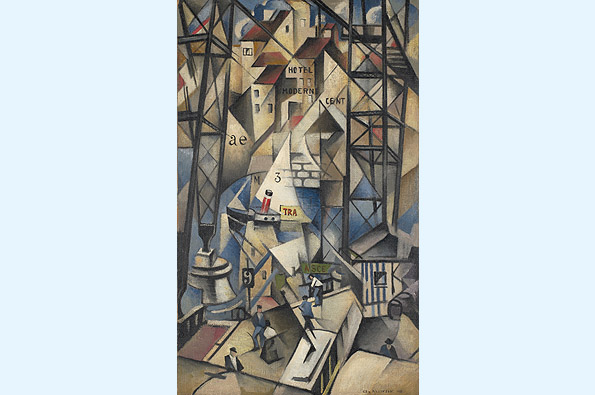 “Le Vieux Port” by C.R.W. Nevinson, 1913Courtesy the artist's estate/ Bridgeman
“Le Vieux Port” by C.R.W. Nevinson, 1913Courtesy the artist's estate/ Bridgeman
1 / 9
ARTISTS born in Europe in the last decade of the 19th century found, almost without exception, that their careers were made (or unmade) by the first world war. In Britain six of the best had studied in London at the Slade School of Art, the top school of the day. From 1893 the towering personality there was Henry Tonks, a former medic turned artist, gaunt and severe.
A stickler for meticulous observation and accurate drawing, Tonks guided his young charges towards the early Renaissance masters, such as Sandro Botticelli and Piero della Francesca. But his students were soon influenced by the debates that were raging around Europe about the direction of the artistic avant-garde. The war interrupted all of this, inspiring some, destroying others. In a memoir written in 1929, well after the end of the war, Tonks described the group—Stanley Spencer, Paul Nash, C.R.W. Nevinson, Mark Gertler, David Bomberg and Dora Carrington—as representing the Slade’s last “crisis of brilliance”.
A new exhibition at the Dulwich Picture Gallery in London illustrates the evolution of this crisis, and also its fallout. The show opens with Bomberg’s vast, dazzling, jagged painting “In the Hold” from 1913-14 (pictured). This almost abstract image, splintered into fragments, sits at odds with the Old Masters of the Dulwich’s permanent collection. It is a dramatic vision of a world soon to be torn apart.
The precocious talent of these young artists is evident in their student work. An early drawing by Nash of an angel fighting a devil on a dark wooded hill reveals a poetic feeling for nature—one that informed his work for the rest of his life. Spencer’s idiosyncratic drawing of a large fairy on a tiny water-lily leaf captures an imagination that strained against conventional rules of composition from the start. Gertler, who like Bomberg was on a scholarship supported by the Jewish Education Aid Society, is represented here with clear, pure, Italianate paintings in a vein Tonks would have approved of. Nevinson, less natively talented, restlessly paints himself in a variety of styles.
Such nascent efforts were radicalised by two big London exhibitions, in 1910 and 1912. With paintings by Van Gogh, Cézanne, Gauguin, Picasso and Matisse, these shows had an immediate impact on the students’ work. Nevinson soon creates kinetic, disorienting images of the modern world—trains, bridges, dance halls—that convey speed and distraction. Bomberg begins to pioneer a unique approach to abstraction, evident in “Jewish Theatre” (1913) and “Bathing Scene” (1912-13). Spencer meanwhile clearly drew on Gauguin to produce the powerfully symbolic “Apple Gatherers” (1912-13).
The war, however, was more profoundly influential. The six artists all survived, but the conflict left each of them changed. Nevinson’s stark, stylised images of soldiers, bombed buildings and the wounded have become a poignant record of the Great War, alongside Nash’s desolate landscapes. Yet after the fighting, traumatised by what he had experienced, Nevinson made few masterpieces and entered a gradual decline. Gertler, excused from service on grounds of poor health, found that the bold, figurative style of his pre-war paintings (evident in “The Rabbi and his Grandchild” and “The Creation of Eve”) had little relevance during and after the war. Dogged by depression and self-doubt, he struggled to recapture his earlier sense of purpose and committed suicide in 1939.
It is a shame that Gertler’s wartime masterpiece, “Merry-Go-Round” (1916), hanging in Tate Britain, is missing from this show, as is Nash’s important 1919 work “The Menin Road”. Bomberg, meanwhile, had an ambitious war commission rejected as “a Futurist abortion”. This devastated his confidence, though he would become an important influence on later artists. Carrington, who lost a brother on the Somme, took refuge from the carnage with Lytton Strachey in the countryside. Despite the strength of her portraits, she never summoned the confidence to show her work publicly and committed suicide after Strachey’s death from cancer in 1932.
The show ends in 1922, when it seemed the earlier promise of these artists would be fulfilled. And indeed, after producing his harrowing images of war, Nash found his ideal subject in nature, as he had been advised to do years earlier at the Slade. Spencer, perhaps buoyed by his strong religious faith and deep attachment to his home village, was able in images like “Unveiling Cookham War Memorial” to find some resolution to the crises he had lived through.
In a letter to a friend in 1945 Nash could not but mourn the pre-war exuberance. “When I came to look into the early drawings I lived again that wonderful hour.” For every member of his generation, he wrote, the years after 1914 ushered in “another life, another world”.
-
-
“Le Vieux Port” by C.R.W. Nevinson, 1913Courtesy the artist's estate/ Bridgeman -
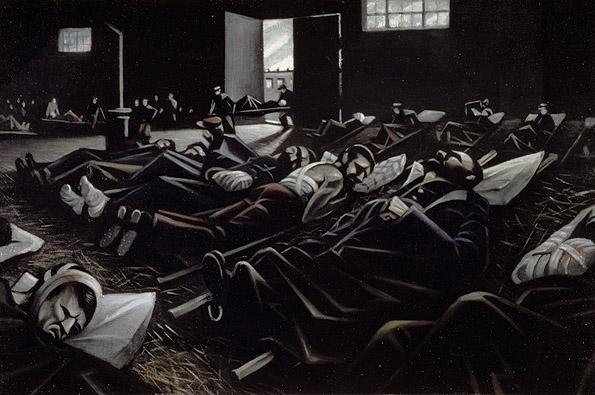 “La Patrie” by C.R.W. Nevinson, 1916-19Birmingham Museums and Art Gallery
“La Patrie” by C.R.W. Nevinson, 1916-19Birmingham Museums and Art Gallery
-
-
“La Patrie” by C.R.W. Nevinson, 1916-19Birmingham Museums and Art Gallery
-
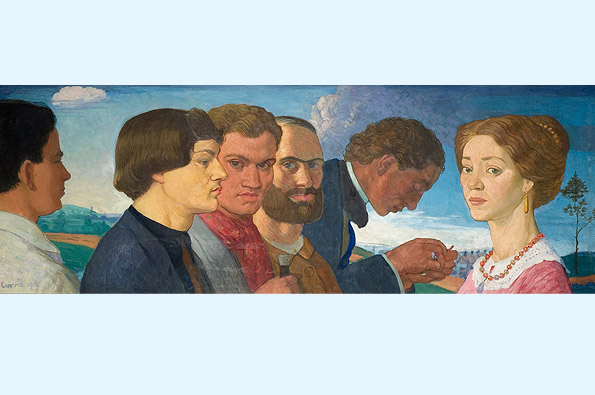 “Some Later Primitives with Madame Tisceron” by John Currie, 1912
“Some Later Primitives with Madame Tisceron” by John Currie, 1912
-
-
“Some Later Primitives with Madame Tisceron” by John Currie, 1912The Potteries Museum and Art Gallery, Stoke-on-Trent
-
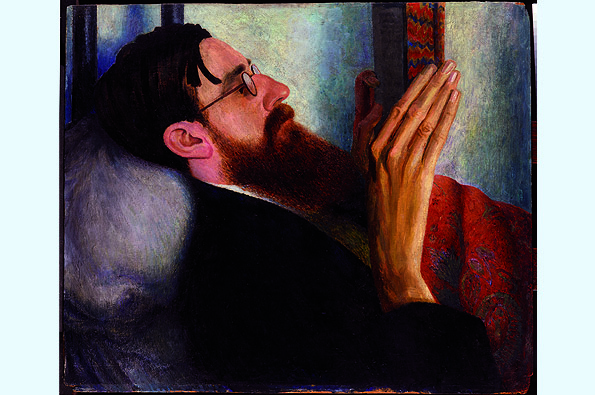 “Lytton Strachey” by Dora Carrington, 1916
“Lytton Strachey” by Dora Carrington, 1916-
-
“Lytton Strachey” by Dora Carrington, 1916National Portrait Gallery, London
-
 “The Fruit Sorters” by Mark Gertler, 1914
“The Fruit Sorters” by Mark Gertler, 1914
-
-
“New Walk Museum and Art Gallery, Leicester
-
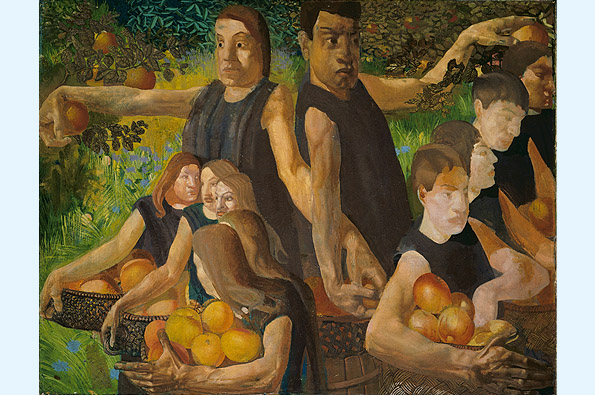 “Apple Gatherers” by Stanley Spencer, 1912-13
“Apple Gatherers” by Stanley Spencer, 1912-13
-
-
“Apple Gatherers” by Stanley Spencer, 1912-13Tate, London
-
“Unveiling Cookham War Memorial” by Stanley Spencer, 1922
-
-
-
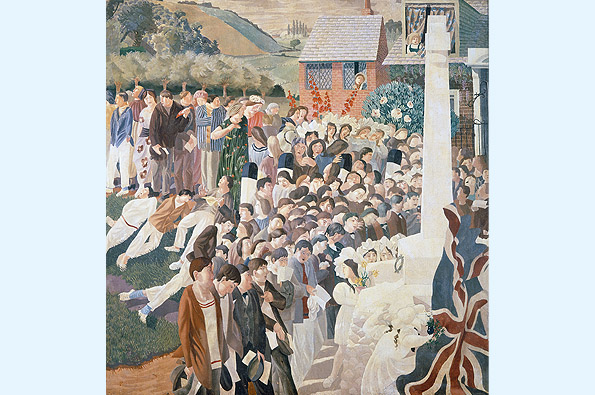 “Unveiling Cookham War Memorial” by Stanley Spencer, 1922Bridgeman
“Unveiling Cookham War Memorial” by Stanley Spencer, 1922Bridgeman -
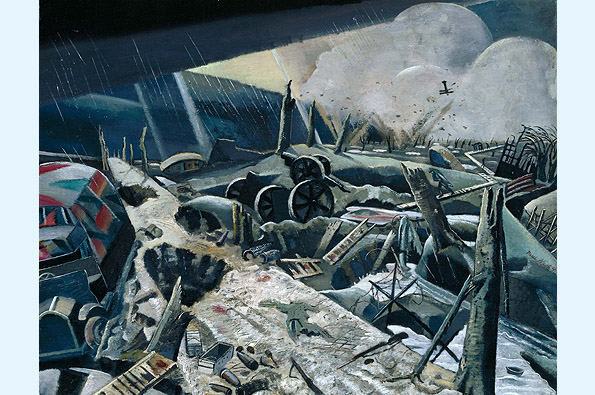 “The Void” by Paul Nash, 1917
“The Void” by Paul Nash, 1917
-
Painting in Britain: 1525-1975
Painting in Britain: 1525-1975John Sunderland (著)*
出版社: Phaidon Press;New York Univ Pr (1976/06)
《英国绘画1525-1975》
作者: John Sunderland摘譯者: 刘明毅, / 唐伯祥
出版社: 上海人民美术出版社
出版年: 1991
书中介绍了英国从1525年开始的绘画史,还附有197幅黑白的图版。
(為 什麼選1525呢 一來1525-1975為450年 好記 二來1525是宗教改革方興未艾之年 (1525. marked an exceedingly complex and difficult. time in Luther's life and the Reformation's story.) 隔年Holbein渡海到英國.....)
沒有留言:
張貼留言